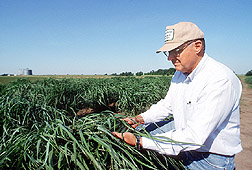U.S. Department of Agriculture researchers have developed an inexpensive way to grade the ethanol potential of perennial grasses at a biorefinery’s loading dock.
 Geneticist Ken Vogel (pictured) was one of a team of USDA’s Agricultural Research Service (ARS) scientists who developed the grading process that costs only about $5 a sample rather than the $300 to $2,000 per sample that conventional analytical methods cost.
Geneticist Ken Vogel (pictured) was one of a team of USDA’s Agricultural Research Service (ARS) scientists who developed the grading process that costs only about $5 a sample rather than the $300 to $2,000 per sample that conventional analytical methods cost.
The process uses near-infrared sensing (NIRS) to measure 20 components in switchgrass biomass that determine its potential value to biorefiners. These components include cell wall sugars, soluble sugars and lignin. With this information, 13 traits can be determined, including the efficiency of the conversion from sugars to ethanol. This is the first time NIRS has been used to predict maximum and actual ethanol yields of grasses from a basic conversion process.
ARS is now working with the Near Infrared Spectroscopy Consortium (NIRSC) to commercialize the process for use at biorefineries.

